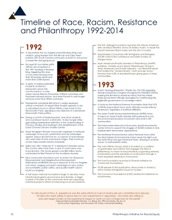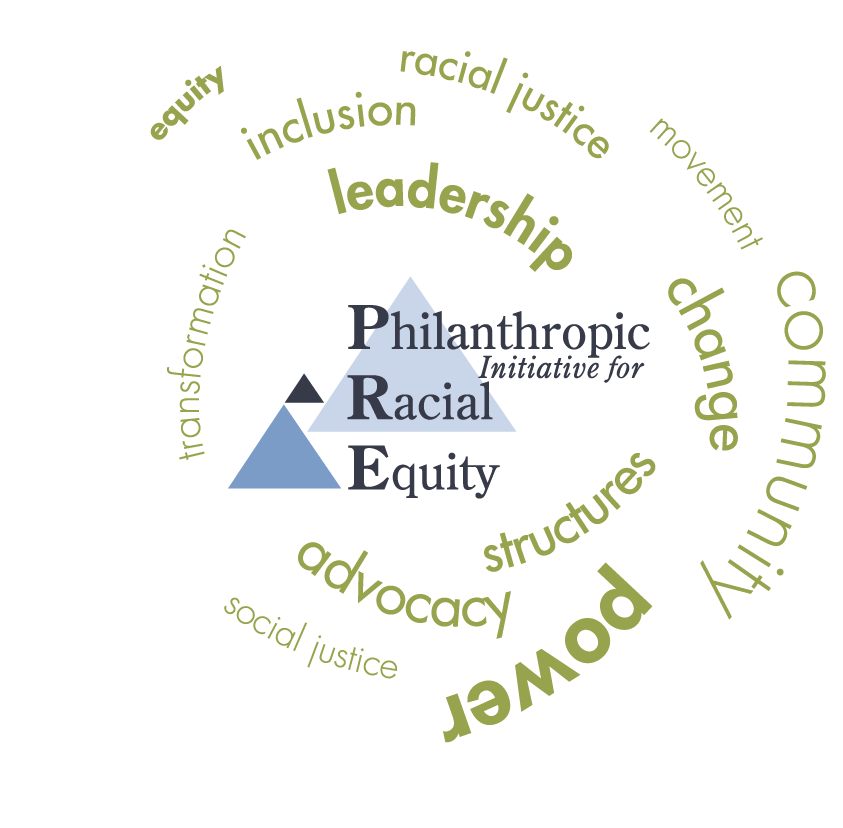Critical Issues Forum Vol. 5. Moving Forward on Racial Justice Philanthropy
Critical Issues Forum Vol. 5. Moving Forward on Racial Justice Philanthropy
Moving Forward on Racial Justice Philanthropy is the fifth volume of the Critical Issues Forum series, which aims to deepen the discourse around important progressive racial justice issues within philanthropy. In this journal we share essays and interviews with activists and funders, tackling a range of current issues, challenges and opportunities as they reflect on the trajectory of racial justice and philanthropy over the past two decades.

Lori Villarosa is the executive director and founder of the Philanthropic Initiative for Racial Equity (PRE).
“Have you seen any progress?” This is a question most of us are asked in our work toward social change. It is asked of ourselves, asked by our funders or boards or others. And when we focus that question on racial justice, a source of ongoing discourse where one’s answer can signify our level of awareness and be taken as a testament of our own righteousness, it’s an even more weighted question.
If we say there is no progress, are we denying huge strides? Are we invalidating reasons to keep trying? On the other hand, if we say there has been great progress, do we risk a self-congratulatory invitation to complacency? Full Text
 By Larry Raphael Salomon, Julie Quiroz, Maggie Potapchuk and Lori Villarosa.
By Larry Raphael Salomon, Julie Quiroz, Maggie Potapchuk and Lori Villarosa.
This historical timeline attempts to capture, in one place, many significant moments, events, controversies and victories that have defined the racial landscape since the turbulent days following the LAPD/Rodney King beating verdict over two decades ago. When communities in Los Angeles rebelled, “race riots” exploded the commonly held myth that our nation had progressed from the explicitly unjust conditions that had defined earlier generations. And in the decades since, the history chronicled in this timeline belies the notion that the U.S. is a “post-racial” society.
For funders seeking to understand and provide resources in support of racial justice work, this timeline also includes some of the key events in philanthropy that were shaped by the incidents, policies and cultural manifestations of race and racism during these years. Full Text Daniel Martinez HoSang is an associate professor of Ethnic Studies and Political Science at the University of Oregon.
Daniel Martinez HoSang is an associate professor of Ethnic Studies and Political Science at the University of Oregon.
In the mid-1990s, public policies to promote racial justice faced a new round of attacks. In California, the bluest of blue states, voters approved ballot measures eliminating public affirmative action and bilingual education programs – ending public education and health care for many immigrants, and expanding the state’s already massive and deeply racialized prison system. Affirmative action programs soon fell in six other states, and the rise of “colorblind” rhetoric among liberals and conservatives alike seemed to signal a decisive transformation in public attitudes about civil rights and racial justice.
Full Text Rick Cohen is the national correspondent of the Nonprofit Quarterly magazine, (NPQ).
Rick Cohen is the national correspondent of the Nonprofit Quarterly magazine, (NPQ).
Editors’ Note: This retrospective look at the past two decades of philanthropy’s approaches to race was primarily based on interviews with 21 racial justice and equity leaders in the field. This article shares their stories, experiences and reflections on how the sector has changed and evolved in addressing race over the past 20 years and into the present. In some cases, they found themselves responding to factors outside of their institutions – incidents and dynamics in which nuances of race beyond the easily observable manifestations of racial animus propelled them to sharpen or deepen their understandings. In others, the impetus came internally, from the intersection of the quality and composition of foundation leadership with the foundations’ social justice missions. This led to grantmaking that wasn’t simply “designated” for specific racial or ethnic groups, but aimed at addressing and rectifying racial disparities that result from complex dynamics.
We offer this mix of reflections recognizing that there was progress made in earlier stages of the field that can easily be forgotten and yet still holds lessons – in spite of being too soon lost in the collective discourse, or buried in reports on foundation shelves. We know it is not comprehensive, and many key moments and actors are still missing, but we believe it helps share a slice of the path of this work. Full Text
 Julie Quiroz is a senior fellow at the Movement Strategy Center.
Julie Quiroz is a senior fellow at the Movement Strategy Center.
Fifty years after the major victories of the civil rights movement, racial justice activists share a sense of bitter dismay at what Judith Browne Dianis, director of Advancement Project, calls a “new normal” of racial injustice that is actually painfully old. “Like the civil rights placard ‘I am a man,”” says Taj James, pointing to the campaign by San Francisco group POWER following George Zimmerman’s acquittal, “we needed to declare again that Black lives matter.” According to James, who began his racial justice work as a Black youth organizer two decades ago and now heads the Movement Strategy Center, “It can feel like we walked back in time to a moment we never left. Full Text

 Interviews and case studies of the foundations were done by Lisa McGill, the principal of LM Strategies Consulting and Maggie Potapchuk, the principal of MP Associates.
As structural racism analysis and concepts have evolved over the past 20 years, forward-thinking foundations have increasingly taken intentional steps to address the root causes of racism and disparities through grantmaking.
This retrospective publication provides PRE with an opportunity to highlight some of the principles, lessons and challenges of this work as experienced by different types of foundations. To select the subjects of the four case studies in this volume, PRE sought out institutions that have engaged in intentional practices to strengthen racial justice grantmaking. We deliberately selected a diverse group of private foundations that are at different stages of integrating structural racism analysis in their work, so that both small and large funders could relate and learn from their experience.
We are extremely grateful that Woods Fund Chicago, The Z. Smith Reynolds Foundation, The California Endowment and the Akonadi Foundation all generously agreed to invest significant time in interviews and share internal material with us. Full Text
Interviews and case studies of the foundations were done by Lisa McGill, the principal of LM Strategies Consulting and Maggie Potapchuk, the principal of MP Associates.
As structural racism analysis and concepts have evolved over the past 20 years, forward-thinking foundations have increasingly taken intentional steps to address the root causes of racism and disparities through grantmaking.
This retrospective publication provides PRE with an opportunity to highlight some of the principles, lessons and challenges of this work as experienced by different types of foundations. To select the subjects of the four case studies in this volume, PRE sought out institutions that have engaged in intentional practices to strengthen racial justice grantmaking. We deliberately selected a diverse group of private foundations that are at different stages of integrating structural racism analysis in their work, so that both small and large funders could relate and learn from their experience.
We are extremely grateful that Woods Fund Chicago, The Z. Smith Reynolds Foundation, The California Endowment and the Akonadi Foundation all generously agreed to invest significant time in interviews and share internal material with us. Full Text Malkia Amala Cyril is the founder and executive director of the Center for Media Justice.
Malkia Amala Cyril is the founder and executive director of the Center for Media Justice.
This essay examines the centrality of strategies for media rights, access and representation as part of a comprehensive strategy for racial equity; and the role of philanthropy in ensuring the racial justice leadership to transform structural racism in the media. The successes of media justice movement-building are highlighted as a targeted approach to resourcing racial equity leadership within and beyond fights for progressive policy reform. Full Text
 Kalpana Krishnamurthy is the policy director at Forward Together.
Kalpana Krishnamurthy is the policy director at Forward Together.
Intersectionality is a term that comes up a lot in social justice work. It comes up when community groups are trying to describe how policies affect multiple people’s identities. It comes up when organizers are trying to push back on messaging that tries to simplify a policy fight to one aspect. It comes up when advocates are describing their political analysis. And it comes up in questions: What exactly is intersectionality? And why is it important for funders to understand it?
For feminists and LGBTQ people of color, having a theoretical framework like intersectionality to analyze how oppression is simultaneous and compounding has been key. This essay discusses the evolution of social change approaches that simultaneously address gender and race, or sexuality and race, and incorporates analysis of funding trends with insights from people of color who work on these issues in philanthropy. It also provides examples of how intersectional efforts can lead to stronger base-building and to policy victories over time, and recommendations to funders. Full Text
